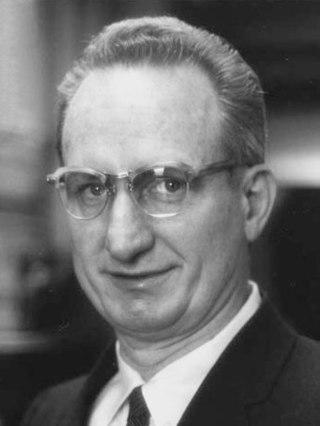
Yang Chen-Ning or Chen-Ning Yang, also known as C. N. Yang or by the English name Frank Yang, is a Chinese theoretical physicist who made significant contributions to statistical mechanics, integrable systems, gauge theory, and both particle physics and condensed matter physics. He and Tsung-Dao Lee received the 1957 Nobel Prize in Physics for their work on parity non-conservation of weak interaction. The two proposed that the conservation of parity, a physical law observed to hold in all other physical processes, is violated in the so-called weak nuclear reactions, those nuclear processes that result in the emission of beta or alpha particles. Yang is also well known for his collaboration with Robert Mills in developing non-abelian gauge theory, widely known as the Yang–Mills theory.

Tsung-Dao Lee was a Chinese-American physicist, known for his work on parity violation, the Lee–Yang theorem, particle physics, relativistic heavy ion (RHIC) physics, nontopological solitons, and soliton stars. He was a university professor emeritus at Columbia University in New York City, where he taught from 1953 until his retirement in 2012.

Leo James Rainwater was an American physicist who shared the Nobel Prize in Physics in 1975 for his part in determining the asymmetrical shapes of certain atomic nuclei.

The Dublin Institute for Advanced Studies (DIAS) is a statutory independent research institute in Ireland. It was established in 1940 on the initiative of the Taoiseach, Éamon de Valera, in Dublin.
José Leite Lopes was a Brazilian theoretical physicist who worked in the field of quantum field theory and particle physics.

Walter Heinrich HeitlerFRS MRIAGerman:[ˈhaɪtlɐ]; 2 January 1904 – 15 November 1981) was a German physicist who made contributions to quantum electrodynamics and quantum field theory. He brought chemistry under quantum mechanics through his theory of valence bonding.

Huang Kun was a Chinese physicist and an academician of the Chinese Academy of Sciences. He was awarded the State Preeminent Science and Technology Award by President Jiang Zemin in 2001.

Wang Ganchang was a Chinese nuclear physicist. He was one of the founding fathers of Chinese nuclear physics, cosmic rays and particle physics. Wang was also a leader in the fields of detonation physics experiments, anti-electromagnetic pulse technology, nuclear explosion detection, anti-nuclear radiation technology, and laser stimulated nuclear explosion technologies.

Deng Jiaxian, also spelled as Chia-Hsien Teng, was a Chinese theoretical physicist, nuclear physicist, member of the Chinese Academy of Sciences, member of the 12th Central Committee of the Chinese Communist Party, and member of the Central Committee of the Jiusan Society. Deng Jiaxian graduated from the National Southwestern Associated University of the Republic of China, then went to the United States to study, and received a doctorate in physics from Purdue University in 1950. Deng Jiaxian made significant contributions to the development of the atomic bomb of the People's Republic of China and was honored as the "Patriot of the Two Bombs". In 1999, he was named the "Patron of the Two Bombs and One Star" by the Chinese government.

Yu Min was a prominent Chinese nuclear physicist. He was an academic of Chinese Academy of Sciences (CAS), a lead nuclear weapon designer in the Ninth Academy, and a recipient of Two Bombs, One Satellite Achievement Medal. Though he personally refused to accept the title, he is honored as “the father of [the] Chinese Hydrogen Bomb”.

Wu Zhengyi was a Chinese botanist and an academician of the Chinese Academy of Sciences (CAS). Wu specialized in Botanical Geography and Medicinal Botany. He is also known by the alternative spellings of 'Wu Cheng-yih', 'Wu Zheng Yi' and 'Cheng Yih Wu'.

Hu Ning was a Chinese physicist and writer.

Ye Qisun, also named Ye Hongjuan (叶鸿眷), was a Chinese physicist and one of the founders of modern physics in China.

Cécile Andrée Paule DeWitt-Morette was a French mathematician and physicist. She founded the Les Houches School of Physics in the French Alps. For this and her publications, she was awarded the American Society of the French Legion of Honour 2007 Medal for Distinguished Achievement. Attendees at the summer school included over twenty students who would go on to be Nobel Prize winners, including Pierre-Gilles de Gennes, Georges Charpak, and Claude Cohen-Tannoudji, who identify the school for assisting in their success.
James "Jim" Hamilton was an Irish mathematician and theoretical physicist who, whilst at Dublin Institute for Advanced Sciences (1941-1943), helped to develop the theory of cosmic-ray mesons with Walter Heitler and Hwan-Wu Peng.

Kê T'ing-sui or Ge Tingsui, also known as T.S. Kê, was a Chinese physicist and writer renowned for his contributions in internal friction, anelasticity, solid state physics and metallurgy. He was the member of the Chinese Academy of Sciences, known for the Kê-type pendulum and Kê grain-boundary internal friction peak named after him. In March 1982, he founded the Institute of Solid State Physics in Hefei, Anhui, China.
Sheila Christina Tinney was an Irish mathematical physicist. Her 1941 PhD from the University of Edinburgh, completed under the supervision of Max Born in just two years, is believed to make her the first Irish-born and -raised woman to receive a doctorate in the mathematical sciences.

Peng Shaoyi was a Chinese physical chemist. Peng was elected as an academician of the Chinese Academy of Sciences (CAS) in 1980. He was a member of China Democratic League since 1956.

Wu Zhonghua, also known as Chung-Hua Wu, was a Chinese physicist. He was a National Advisory Committee for Aeronautics (NACA) researcher, Tsinghua University professor, and Founding Director of the Institute of Engineering Thermophysics of the Chinese Academy of Sciences (CAS). He pioneered the general theory of three-dimensional flow for turbomachinery, which has been widely used in aircraft engine designs. Wu and his wife Li Minhua were both academicians of the CAS.
Jean-Bernard Zuber is a French theoretical physicist.
















